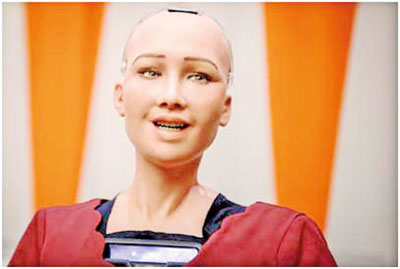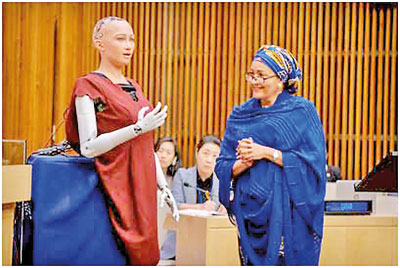Sunday Times 2
Is UN planning to replace humans with machines and robots?
UNITED NATIONS, (IPS) – The United Nations – once facetiously described as an institution whose bloated bureaucracy moves at the leisured pace of a paralytic snail — is steadily zooming into the field of fast-paced, cutting-edge digital technology where humans may one day be replaced with machines and robots.
Is this a glimpse into a distant future or a far-fetched fantasy?

Robots as UN staff. Pic Credit: UN Photo/Manuel Elias
The technological innovations currently being experimented with at the UN include artificial intelligence (AI), machine-learning, e-translations (involving the UN’s six official languages where machines are taking over from humans) and robotics.
The United Nations says it has also been using unarmed and unmanned aerial vehicles (UAVs), or drones, in peacekeeping operations, “helping to improve our situational awareness and to strengthen our ability to protect civilians”.
At a joint meeting of the UN’s Economic and Social Council (ECOSOC) and its Economic and Social Committee, a robot named Sophia had an interactive session last year with Deputy Secretary-General Amina J. Mohammed.
Among the technological innovations being introduced in the world body, and specifically in the UN’s E-conference services, is the use of eLUNa –Electronic Languages United Nations — “a machine translation interface specifically developed for the translation of UN documents.”
What distinguishes eLUNa from commercial CAT (Computer-Assisted Translation) tools is that it was developed entirely by the United Nations and is specifically geared towards the needs and working methods of UN language professionals, says the UN.
Besides the UN headquarters in New York, the spreading eLUNa network includes the UN Office in Geneva (UNOG), the UN Office in Vienna (UNOV), the UN Office in Nairobi (UNON) and the Economic and Social Commission for Western Asia (ESCWA) based in Beirut.
Secretary-General Antonio Guterres says the breakthrough has been brought about by a combination of computing power, robotics, big data and artificial intelligence—even as they generate revolutions in healthcare, transport and manufacturing worldwide.
“I am convinced that these new capacities can help lift millions of people out of poverty, achieve the Sustainable Development Goals (SDGs) and enable developing countries to leapfrog into a better future,” he predicted last year.
Addressing the executive heads of some 31 UN agencies last November, Guterres singled out some of the challenges emanating from global mega trends and technological advancements in four distinct areas — artificial intelligence; cyberspace; biotechnology; and the impact of technological applications on peace and security — “with a view to identifying specific entry points for UN engagement and to determine focus areas where the UN system can add value.”
He said, he is working with colleagues throughout the entire UN system to determine “how our organization can better harness the benefits and address the risks of new technologies, and how the United Nations itself can make better use of innovation.”
Christopher Fabian, Principal Adviser in the Office of Global Innovation at the UN’s children’s agency UNICEF, one of the agencies making headway in AI, told IPS that UNICEF is using Machine Learning and Artificial Intelligence (ML/AI) for both programmatic and operational purposes.
Based on the “Principles of Digital Development,” the organisation promotes applications and development of Machine Learning and Artificial Intelligence with equity at their core, whether through fair and open training sets or through discussions on algorithmic equity and information poverty, he added.

Sophia the robot had an interactive session last year with Deputy Secretary-General Amina J. Mohammed
For example, he pointed out, UNICEF is developing Magic Box, a collaborative platform that is made possible through the contributions of private sector partners such as Telefonica, Google, IBM, Amadeus and Red Hat, which share their data and expertise for public good.
By harnessing real-time data generated by the private sector, UNICEF can gain critical insights into the needs of vulnerable populations, and make more informed decisions about how to invest its resources to respond to disaster, epidemics and other challenges, said Fabian.
In addition, UNICEF, through its Venture Fund, the first financial vehicle of its kind in the United Nations, collaborates with innovators on the ground in UNICEF programme countries to build and test new solutions at the pace required to keep up with the rapidly evolving challenges facing children.
The Venture Fund was launched by UNICEF in 2016 — a $17.9 million investment fund — applying lessons learned over 8+ years, undertaking the complex work of helping to identify and grow innovations for children.
The UNICEF Venture Fund makes $50–100K early stage investments in technologies — including data science and AI — for children, developed by UNICEF country offices or companies in UNICEF programme countries.
By providing flexible funding to early-stage innovators, it allows UNICEF to quickly assess, fund and grow open-source technology solutions that show potential to positively impact the lives of vulnerable children, declared Fabian. Meanwhile, Guterres said new technologies could enhance the maintenance of peace and security, including disarmament and non-proliferation objectives, by providing new tools and augmenting existing ones.
For example, he noted, the use of shared ledger technology such as Blockchain in nuclear safeguards, or machine learning in multilateral disarmament verification — as the Comprehensive Nuclear-Test-Ban Treaty Organization is pioneering.
The writer can be contacted at thalifdeen@ips.org

